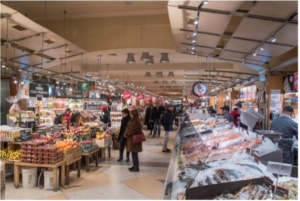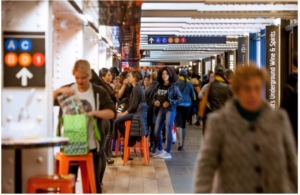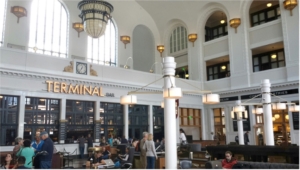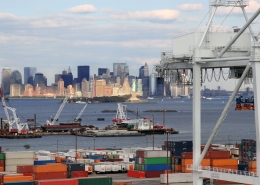At train and bus stations, we all appreciate a wide variety of retail outlets from newsstands to restaurants. However, the retail landscape has rapidly changed due to the decline in transit ridership and a shift towards online purchasing. The increasing number of retail vacancies at stations is disconcerting to transit users, transit agencies and everyone who wants to promote transit use.
That is why Eno recently hosted an expert panel titled “Retail at Train and Bus Stations: Innovative Strategies to Enhance Revenue, Amenities, Ridership, and Safety.” Nearly 250 people heard from three panelists — Susan Fine (principal of Fine Development Partners), Charles Di Maggio (CEO of Greystone Management Solutions), and Laura Barr (senior vice president for consumer and retail at CBRE) — on a live webinar (a video is now available here.)
Jointly sponsored by the Eno Center and the American Planning Association’s Transportation Planning Division, the panelists talked about how innovative transit agencies, property managers, and developers are adapting to a changing retail climate – with strategies designed to enhance station amenities, attract more riders, improve safety, and increase transit agency revenues.
Transit stations all across the country have been experiencing high rental vacancy rates since the COVID pandemic began, even though transit agencies have taken drastic actions to retain their tenants. For example, in October 2020, New York’s Metropolitan Transportation Authority (MTA) reduced rents to only 10 percent of the tenant’s base rate or 10 percent of gross sales, whichever was higher. With ridership and retail sales still far below pre-pandemic levels, many of MTA’s retail tenants are still only paying 20 percent of their pre-covid rents. If the MTA tried to increase their rents to pre-covid levels, now, it would result in an increased number of tenant defaults and vacancies, placing the MTA in the position of terminating tenancies and incurring untold legal expenses.
This article starts with a brief discussion of some of the challenges to improving transit retail. Then, we identify seven effective strategies to overcome these challenges. Next week, we will share even more ways to create lively and successful retail spaces in transit stations. These strategies are useful to every transit agency, regardless of whether they are considering incorporating retail into a new light rail station or finding tenants for a 50-year-old bus station.
The Challenges
Transit stations can be appealing to retailers because they have consistent traffic patterns and a captive audience. Moreover, retailers usually know the types of goods and services that riders are interested in purchasing.
However, Eno’s panelists noted numerous challenges that transit agencies face in creating thriving retail environments. First and foremost has been the precipitous drop in transit ridership compared to pre-Covid levels. Transit stations can only sustain a certain amount of retail space and that number has been reduced because of lower ridership.
Another challenge is that transit retail is vulnerable to the transit operational environment. While a shopping mall owner’s focus is maximizing value from its retailers, the priority of a transit agency is to operate safe transit services. Transit agencies and retailers might have different perspectives about signage, delays, crowded corridors, music, and people lingering.
Transit stations typically attract very different types of tenants than airports and shopping malls. Many airline passengers wait an hour or two at an airport, but transit users typically arrive at a station just a few minutes before their trains and buses leave, “So you’re really looking more for a grab-and-go item,” Charles Di Maggio said.
Di Maggio understands the market because he oversees teams that manage dozens of transit retail locations. As the designated real estate representative for Boston’s MBTA, Philadelphia’s SEPTA, and New York’s MTA – his firm develops marketing and leasing strategies to find tenants for retail spaces and then negotiates leases, helps tenants get up and running, and takes care of billing and rent collections.
He has found that accommodating retail in older underground transit stations is especially challenging because many of them do not have water or sewer lines. A typical 1950s subway station might have sold newspapers and candy bars, but many of today’s retailers want to sell food and freshly brewed coffee. In Di Maggio’s experience, the startup expenses for a business creating retail space below ground can be four times more than above-ground, because of insurance, fire suppression equipment, electrical upgrades, and other expenses.
Another issue raised was the difficulty of operating across multiple jurisdictions. Transit agencies can get frustrated dealing with all the different processes required for building permits and zoning changes. Moreover, some municipalities will resist certain uses in stations because they want to protect retailers outside of their stations.
Over the course of an hour, the webinar panelists identified the following seven strategies to overcome challenges and improve retail in transit stations.

Photo of New York’s Grand Central Market in 2019 (Credit: Wikimedia Commons)
#1. Think About Merchandising Before Creating a Space
When designing (and redesigning) stations, transit agencies need to think about the needs of both retailers and potential customers during the design process. Extensive analysis needs to be conducted regarding the types of retail that will be accommodated, where they should be best located, the infrastructure and logistical needs of businesses, and the amenities that can help make them successful and vibrant.
Laura Barr emphasized the value of incorporating retailers’ needs into the design process. She leads a California-based CBRE team that works with a wide range of commercial developers and retailers. Barr’s team leases retail space on behalf of major commercial venues such as Thrive City and Mission Rock in San Francisco.
Her team often gets involved in the design of retail space very early in the development process. They conduct preliminary studies even before a developer has obtained all the required legal approvals and permits needed to begin construction. CBRE considers circulation paths, service areas, storage spaces, and other facilities that retailers and their customers need. They also create design guidelines for retailers’ facades, lighting, signage, flooring, and other features.
#2. Develop a Retail Plan
Transit agencies trying to create successful retail spaces cannot just advertise “space available.” Barr talked about the importance of developing an overall merchandising plan. An important early step is to create a list of desired retail categories such as a particular type of coffee shop, specific categories of fast casual food, and types of services.
When done properly, the leasing process should be proactive and intentional, not reactive. That relates to every aspect of leasing including identifying potential retailers, marketing locations, showing a space, and negotiating a lease.
Every location is going to be different. Agencies need to determine whether they are trying to market to non-transit users who live and work nearby. They also have to understand all the competing and complementary uses in the neighborhood.
Although retail is changing, Barr said, “There’s a huge misconception that retail is dying … it’s completely overblown and I see it in news articles all the time as though it’s a given that the Internet has somehow killed retail. It hasn’t, it’s changed it, and changed it for the better in many ways.” She noted that “It is a vast misunderstanding that it’s just easy and cheap to sell online.”
#3. Contact Potential Tenants Early On
As agencies develop their lists of categories and tenants, they must reach out to potential tenants and provide them with information about potential customers. Retailers should be given the information that transit agencies routinely collect such as the number of customers, their age and income levels, and the busiest times of days.
The panelists all emphasized a simple but critical lesson – learn from potential tenants. If you want a gourmet café in your transit station, then find some successful cafés in your area and talk to the owners and managers. Find out what it would take to get them to open a café in your station.
Susan Fine explained how this strategy worked for her.
As the head of her own development company in 2012, Fine signed a master lease with the MTA to develop retail space along a two-block long underground concourse at the Columbus Circle subway station. This was the first privately financed project within the city’s subways. At the time, Jeffrey Rosen, the MTA’s director of real estate said, “The private sector has a particular expertise that is beneficial to us and frees us up to focus on running the system.”

Photo of Columbus Circle subway station. Courtesy: Turnstyle Underground Market
At Columbus Circle, she wanted to attract the best tea shop and the most creative donut shop to the Columbus Circle Station. She talked to the owners of those types of stores and then used what she learned to develop both a merchandising plan and design guidelines.
#4. Consider Attracting Non-Riders to a Station
Some transit agencies have successfully attracted non-transit users to their retail space. Di Maggio talked about how a deli at a suburban station filled a niche in the community by catering to commuter railroad riders in the morning and nearby residents in the afternoon. Fine said that dog grooming and other services located in transit stations can often attract a wide range of customers.
Successful retail at a transit station can be a major destination point in urban areas. For example, Union Station in Washington D.C. and Denver’s Union Station attracts residents who live and work nearby to shop and eat during lunchtime.

Photo of Denver’s Union Station (Credit: Amy Aletheia Cahill, Wikimedia Commons)
#5. Choosing Tenants that Best Serve Riders
Transit agencies need to focus on merchandise that will best serve their riders. Barr said that if you do this right and keep the tenants’ priorities foremost in your minds, you will best serve riders and end up with the most productive tenants. If a transit agency finds the right tenants that meet transit customers’ needs, the retailers are more likely to succeed. For example, if many commuters are interested in eating a take-out breakfast sandwich, finding a shop owner who can successfully fulfill those needs will mean a win for the agency, its transit riders, and the retail owner.
Transit agencies have to know their customers and the retail mix that reflect transit’s diverse ridership. Fine said that one mistake she made in Manhattan was going “too high-end.” She realized after her Columbus Circle station stores opened that in New York, “Everybody rides the subway, everybody takes buses. You have to go high and low.”
#6. Affordable Rents
High rents and security deposits are a major barrier to potential tenants. No one wants a retailer to open up a shop and then go bankrupt a few months later because it was unable to pay its rent. If agencies are not willing to reduce their rents, they can offer a long free-rent period to help retailers get started. The panelists also agreed that rents based on a percentage of sales are an enticing way to attract retailers.
#7. Create Turnkey Spaces
Laura Barr explained that the cost to build out space is an even greater obstacle than the cost of rent. Tenants, she said, “are going to care a lot less about rent if they’re making money.”
Depending upon the location and a retailer’s requirement, build-out costs can include new walls and flooring, as well as upgrading electric lines, plumbing, heating, and air conditioning. In addition, every retailer needs to worry about fixtures, equipment, utility connections, and permits.
Besides lacking the financial resources needed to undertake a build-out, many retailers have neither the time nor expertise to manage a construction project. Think about it – you would not expect someone with a talent for embroidering hats to be an expert in selecting ventilation systems.
That is why providing a renovated space for retailers, especially small business owners, can help attract more tenants. The retailer can add their own finishes and features, but it certainly helps to give them a “vanilla box” space, one that has finished walls and ceilings, as well as the basic mechanical systems that are needed.
Read the next article in the series by following the link here.
















